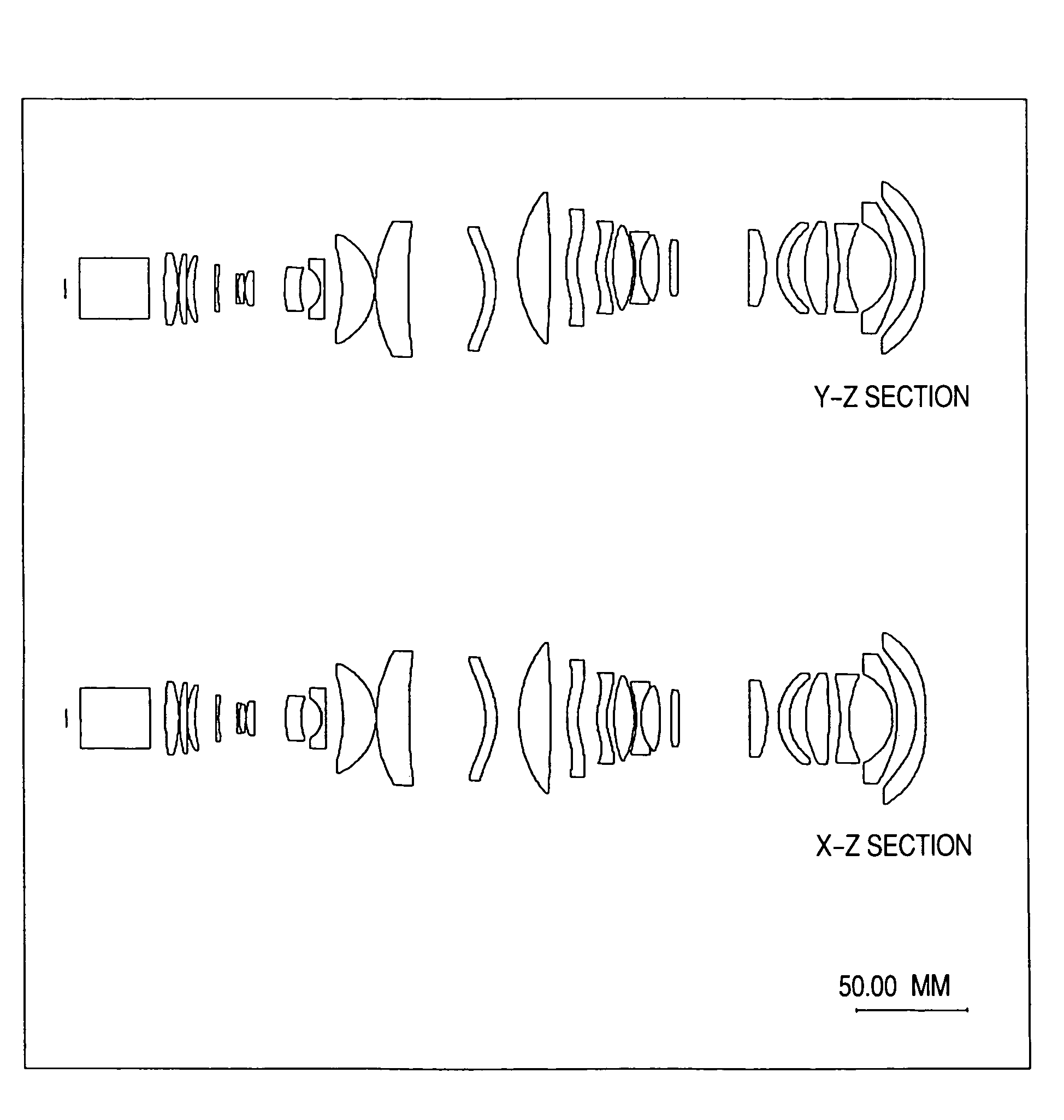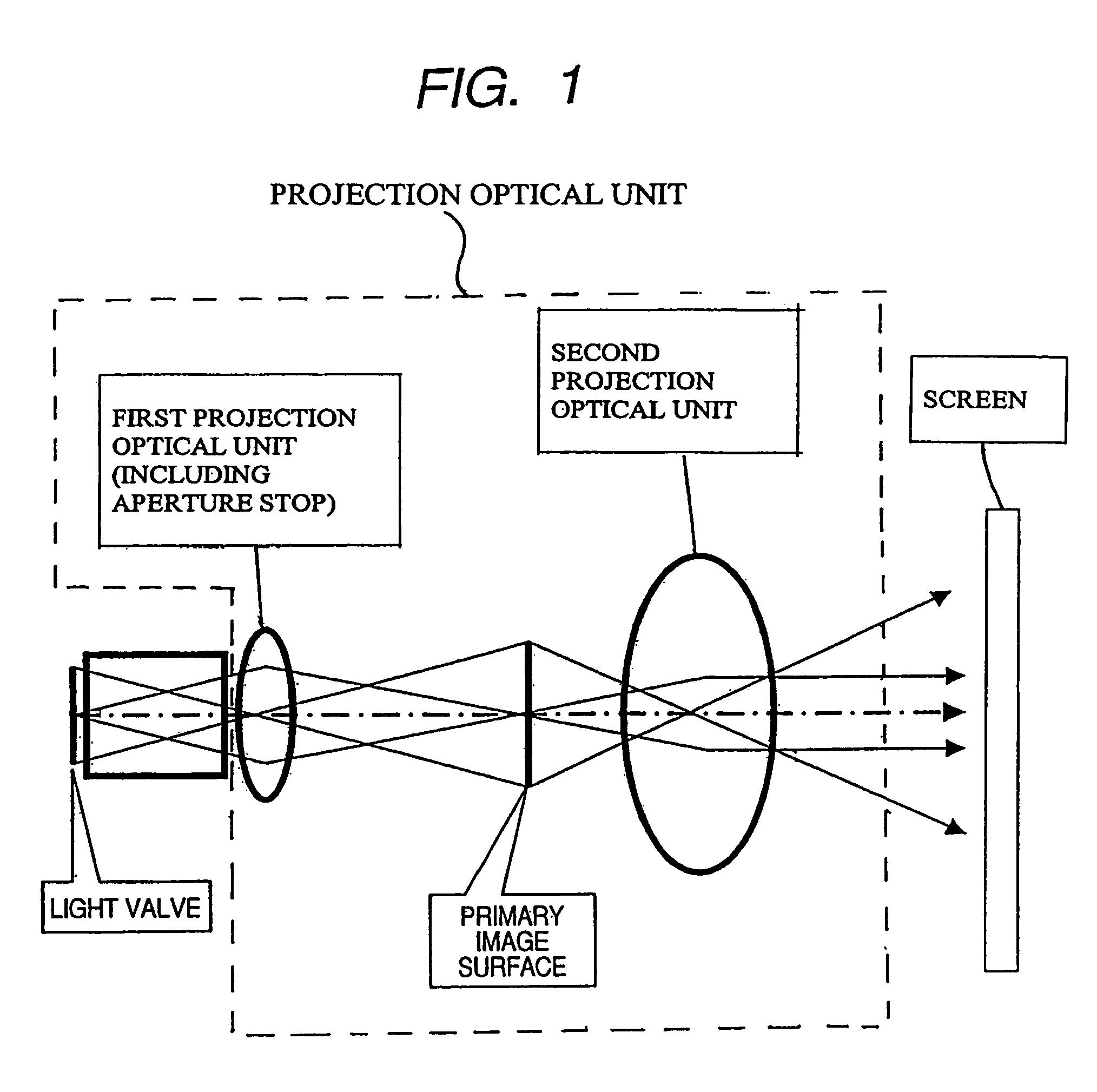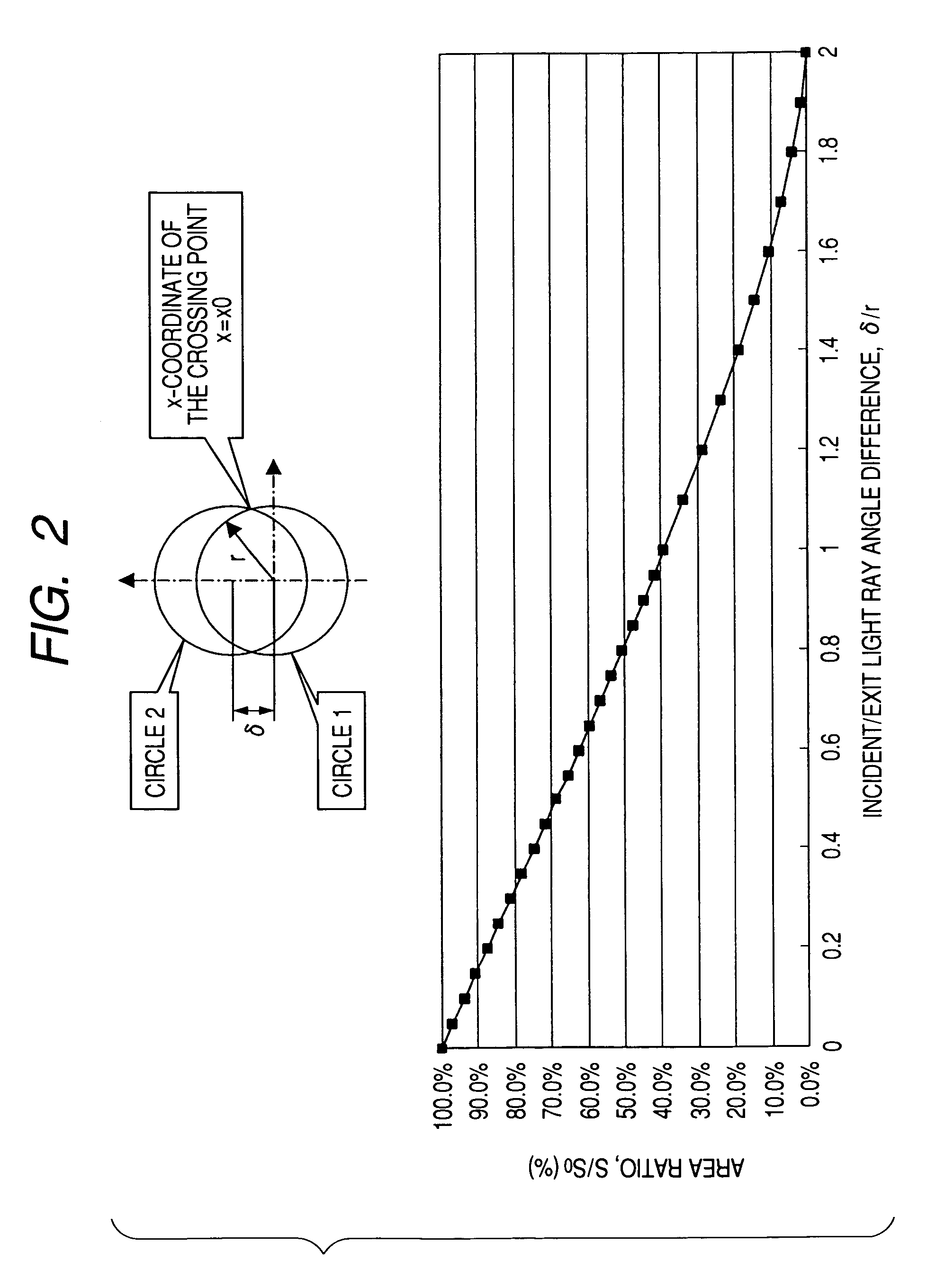Projection optical unit and projection image display apparatus
a projection optical unit and projection image technology, applied in the direction of printers, cameras, instruments, etc., can solve the problems of reducing the thickness of the rear-view mirror, difficult and difficult to achieve such wide-angle imaging, so as to achieve wide-angle imaging and improve the focusing performance. , the effect of improving the focusing performan
- Summary
- Abstract
- Description
- Claims
- Application Information
AI Technical Summary
Benefits of technology
Problems solved by technology
Method used
Image
Examples
embodiment 1-1
[Embodiment 1-1]
[0096]Embodiment 1 of a first projection optical unit is described using FIGS. 3 to 12 and Table 1.
[0097]
TABLE 1Radius ofIntersurfaceSurface No.CurvatureDistanceGlass MaterialObject surface∞6.5281∞31.342BSC7_HOYA2∞7.333190.86.1TAF3_HOYA4−55.50.2567.0593.29TAF3_HOYA6382.40.2734.83.61TAF3_HOYA860.1729.79−268.571EFD8_HOYA1042.278.311−439.450.8EFD8_HOYA1217.9763.02FCD1_HOYA13−400.214(Aperture stop21.1153.85BACD18_HOYAsurface)1584.814.141650.6166.92EFD4_HOYA1725.9439.3918−11.0081.8FCD1_HOYA19605.747.8620−72.614.58TAF3_HOYA21−28.10.22265.3114.71TAF3_HOYA23264.9234.8224−31.655.11PMMA25−31.11351st enlarged∞0image surface
[0098]
Surface No.KABCDE2402.6583E−05−7.3374E−081.4933E−10−1.3814E−135.4234E−172503.7074E−05−1.1429E−072.2442E−10−2.0717E−138.0805E−17
[0099]FIG. 3 is a configuration diagram and spot diagram of a first projection optical unit. This figure indicates the way the luminous flux irradiated from an image display element in a telecentric state converges telecentrical...
embodiment 1-2
[Embodiment 1-2]
[0106]Embodiment 2 of a first projection optical unit is described below using FIGS. 13 to 22 and Table 2.
[0107]
TABLE 2Radius ofIntersurfaceSurface No.CurvatureDistanceGlass MaterialObject Surface∞6.528(Panel surface)1∞31.342BSC7_HOYA2∞7.333176.22376.1TAF3_HOYA4−46.360.2536.33453.99TAF3_HOYA6106.50.2758.8952.82TAF3_HOYA865.4366.879−79.82731EFD8_HOYA10297.89.8811−102.380.8EFD8_HOYA1215.96363.02FCD1_HOYA13−32.730.214(Aperture stop18.65023.85BACD18_HOYAsurface)1531.106617.971623.917.5EFD4_HOYA1719.57.5418−11.253783211.8FCD1_HOYA19217.6311.3520−7513.47TAF3_HOYA21−30.68140.22257.047311.85TAF3_HOYA23305.564222.9524−37.40723.5PMMA25−48.90257.8761st enlarged∞0image surface(Image surface)
[0108]
Surface No.KABCDE2403.4526E−05−3.6247E−083.3065E−11−1.4755E−143.6803E−182503.5425E−05−5.1937E−088.6015E−11−9.3416E−145.0304E−17
[0109]FIG. 13 is a configuration diagram and spot diagram of Embodiment 2 of a first projection optical unit according to the present invention. This figure ind...
embodiment 1-3
[Embodiment 1-3]
[0116]Embodiment 3 of a first projection optical unit is described below using FIGS. 23 to 32 and Table 3.
[0117]
TABLE 3Radius ofIntersurfaceSurface No.CurvatureDistanceGlass MaterialObject surface∞6.52801∞31.342BSC7_HOYA2∞7.333127.70526.1TAF3_HOYA4−49.55080.2534.27474.1764TAF3_HOYA6104.15700.2731.62375.7931TAF3_HOYA834.67215.16519741.76371.8EFD8_HOYA1032.17165.857211−33.54330.5618EFD8_HOYA1215.46282.7796FCD1_HOYA13−27.31830.214(Aperture stop21.14043.85BACD18_HOYAsurface)15302.988916.00961628.35316.6145EFD4_HOYA1722.60326.938418−11.36891.8FCD1_HOYA19212.006510.591120−89.016312.8067TAF3_HOYA21−31.24390.22259.115510.4768TAF3_HOYA23256.477432.959024−38.03083.5PMMA25−35.15106.22081st enlarged∞0image surface(Image surface)
[0118]
Surface No.KABCDE2402.9332E−05−3.1299E−083.7631E−11−2.2287E−144.7490E−182503.6927E−05−4.4805E−085.1104E−11−1.8533E−14−1.4722E−18
[0119]FIG. 23 is a configuration diagram and spot diagram of Embodiment 3 of a first projection optical unit according ...
PUM
| Property | Measurement | Unit |
|---|---|---|
| field angle | aaaaa | aaaaa |
| cone angle | aaaaa | aaaaa |
| cone angle | aaaaa | aaaaa |
Abstract
Description
Claims
Application Information
 Login to View More
Login to View More - R&D
- Intellectual Property
- Life Sciences
- Materials
- Tech Scout
- Unparalleled Data Quality
- Higher Quality Content
- 60% Fewer Hallucinations
Browse by: Latest US Patents, China's latest patents, Technical Efficacy Thesaurus, Application Domain, Technology Topic, Popular Technical Reports.
© 2025 PatSnap. All rights reserved.Legal|Privacy policy|Modern Slavery Act Transparency Statement|Sitemap|About US| Contact US: help@patsnap.com



